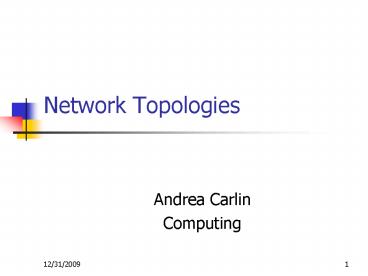Network Topologies - PowerPoint PPT Presentation
1 / 18
Title: Network Topologies
1
Network Topologies
- Andrea Carlin
- Computing
2
NETWORK TOPOLOGY?
- A topology refers to the manner in which the
cable is run to individual workstations on the
network. - In other words the way a network is laid out.
3
There are 3 basic Network Topologies
- 1. The Bus
- 2. The Star
- 3. The Ring
4
What is a bus topology?
- A bus topology connects each computer (node) to
a single segment trunk. - A trunk is a communication line, typically coax
cable, that is referred to as the bus. - The signal travels from one end of the bus to the
other. A terminator is required at each end to
absorb the signal so it does not reflect back
across the bus.
5
- In a bus topology, signals are broadcast to all
stations. Each computer checks the address on the
signal (data frame) as it passes along the bus. - If the signals address matches that of the
computer, the computer processes the signal. - If the address doesnt match, the computer takes
no action and the signal travels on down the bus.
6
Node
Drop Line
Cable (or Backbone)
terminator
7
Advantages of the BUS
- 1. Easy to implement and extend
- 2. Well suited for temporary networks that
must be set up in a hurry - 3. Typically the cheapest topology to
implement - 4. Failure of one station does not
affect others
8
Disadvantages of the Bus
- 1. Difficult to administer/troubleshoot
- 2. Limited cable length and number of nodes
- 3. A cable break can disable the entire
network - 4. Maintenance costs may be higher in the
long run - 5. Performance degrades as additional
computers are added
9
What is a Star topology?
- All of the stations in a star topology are
connected to a central unit called a hub. - The hub offers a common connection for all
stations on the network. Each station has its own
direct cable connection to the hub. - In most cases, this means more cable is required
than for a bus topology. However, this makes
adding or moving computers a relatively easy
task simply plug them into a cable outlet on the
wall.
10
Node or station
cable
11
- If a cable is cut, it only affects the computer
that was attached to it. This eliminates the
single point of failure problem associated with
the bus topology. (Unless, of course, the hub
itself goes down.)
Star topologies are normally implemented using
twisted pair cable, (UTP). The star topology is
probably the most common form of network topology
currently in use.
12
Advantages of the Star
- 1. Easy to add new stations
- 2. Easy to monitor and troubleshoot
- 3. Can accommodate different wiring
13
Disadvantages of the Star
- Failure of hub cripples attached stations
- More cable required
14
What is a Ring topology?
- A ring topology consists of a set of stations
connected serially by cable. - In other words, its a circle or ring of
computers. There are no terminated ends to the
cable - The signal travels around the circle in a
clockwise direction.
15
cable
Multistation Access Unit
16
- Under the ring concept, a signal is transferred
sequentially via a "token" from one station to
the next. - When a station wants to transmit, it "grabs" the
token, attaches data and an address to it, and
then sends it around the ring. - The token travels along the ring until it reaches
the destination address. - The receiving computer acknowledges receipt with
a return message to the sender. The sender then
releases the token for use by another computer.
17
Advantages of the Ring
- 1. Growth of system has minimal impact on
performance - 2. All stations have equal access
18
Disadvantages of the Ring
1. Most expensive topology
2. Failure of one computer may impact
others 3. Complex































